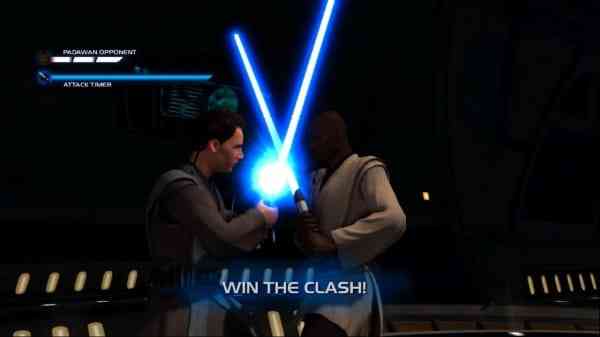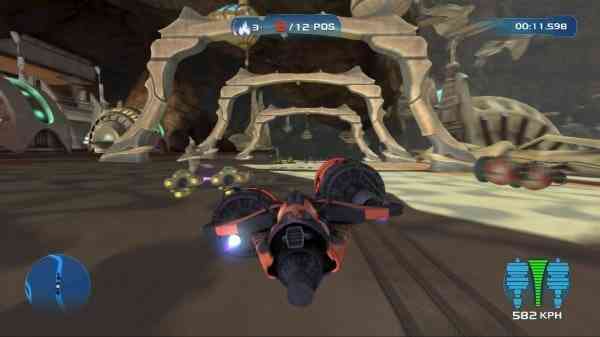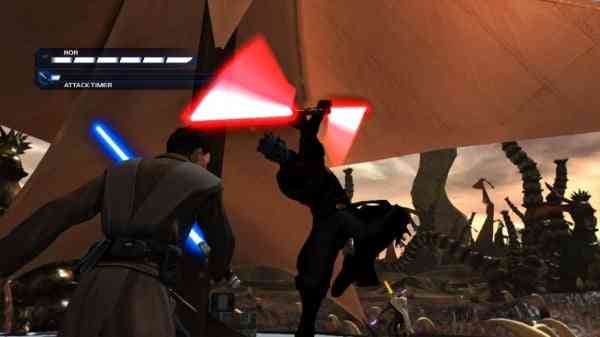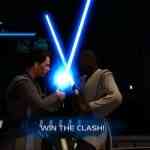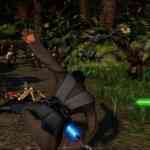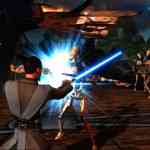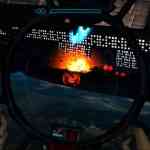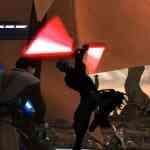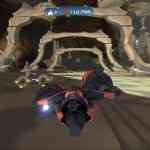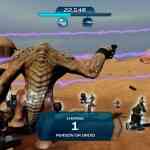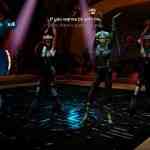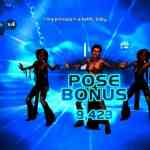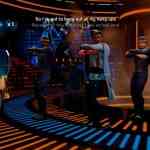Microsoft’s Kinect has been getting some love lately. I had the chance to review Kinect Rush last week, and now I have had the chance to review Kinect Star Wars. I was at E3 2010 when Microsoft announced Kinect’s final name, and at that presentation they showed video footage of Kinect Star Wars, much to the glee of many fans in the arena. Well, almost 22 months later, Kinect Star Wars has been released to the masses. So, the big question is: “Is this the Star Wars game you’re looking for?”
There is a story mode that has some promise in Kinect Star Wars. This mode is called Jedi Destiny: Dark Side Rising. It places you in the role of a young padawan in training under a famed Jedi Master. You begin your adventure in a Jedi Academy ship where you learn the basics of the game’s control, and you land on the Wookie planet Kashyyyk where your adventure begins. The story takes place during the Clone Wars, and in regards to the movie’s timeline it occurs between Episode I and Episode II. What is most notable about the single-player adventure is that it highlights many well-known Star Wars moments, from speeder-bike chases, manning the laser guns of the Millennium Falcon, to blowing up a Death Star just to name a few.
One of the biggest hypes since the unveiling of Kinect Star Wars in 2010 was that the Kinect sensor would allow you to literally live out your dream to play as a Jedi, Lightsaber and all. And although the initial feeling of this gameplay element during the training stages shows promise, once you truly start to battle the various enemies and venture though the game using your force powers, things start to fall apart more quickly then I thought they would.
Controlling your on-screen character is simple. You swing your right arm to swing your Lightsaber. This leaves your left arm free to “use the force” in various methods (e.g. force push, pick up objects/enemies, etc.). You move forward by stepping forward, kick your foot in the air to kick on-screen, and you move left or right by leaning in one of those directions. I should note that you don’t actually walk in the game as your adventure is basically on rails, and when you do step forward you do a ‘speed burst’ that takes your on screen character a specific length forward on the screen and then you stop. You can also jump which allows your on-screen character to jump too.
At glance the control seems really cool, and it feels neat for a short time, but once you start to battle, and in this case it is on Kashyyyk where numerous battle droids make their presence felt, Kinect Star Wars starts to show its weaknesses. First off the sensor cannot keep up to the speed of your movements. So if you start to wield your Lightsaber quickly there is a delay mimicking your movements on the screen. There are even times when your Lightsaber does not mimic your movement at all. Add to this woe that using the force is even more frustrating. From your force pushes to picking up and throwing objects/enemies with your force power, it seems to be more luck then accuracy when you manage to do such.
Many people have said “Oh don’t worry, this game is for kids, so the control is not an issue”, well I have to say that the “T” rating on the box does not mean it’s for kids people, so this excuse is not enough. Kinect Rush on the other hand is a kid’s game, so I can deal its control issues, but for a game that is aimed as Star Wars fans, which are generally much older, this is not acceptable at all.
Along with the main story mode comes some pretty neat mini-games. Podracing is one of the highlights, with single races or a mini-story mode called Destiny. Controlling the podracers is quite intuitive and I was impressed by this part of the game. By putting your arms in the air you take control of your pod as you pull back your arm that corresponds to the direction you wish to turn. If I have any complaint here it is that you can get tired pretty quickly as you keep your arms in air moving them back and forth to steer. I think that people will enjoy this mode as it has a good sense of speed and has some great racing circuits for you to navigate.
Another mini-game that some should enjoy is Rancor Rampage. Here you become a large and lumbering Rancor, and you run amok destroying everything in your sight. You will charge through crowds and buildings, and even have the opportunity to pick up objects, as well as residents, while you are creating destruction and mayhem. This mode is pretty neat and allows you to take out the frustration of the game’s overall controls in a manner that can earn you some interesting achievements to say the least.
One of the biggest surprises of Kinect Star Wars is the dance mini-game called Galactic Dance Off. Yes, you heard me right, a dance mini-game in a Star Wars game. I was somewhat mixed to this. Being that I saw the original Star Wars in the theatre in 1977 as a young child, to say that I have been a fan of the movies is an understatement. To see storied characters such as Han Solo and Princess Leia busting a move and grinding away on screen was somewhat disturbing. That being said, I was somewhat amazed with how well the mechanics of the dance mode worked as a game. The Kinect was responsive in registering my dance moves, and when I found myself having the wrong rhythm, my on-screen character highlighted the area I was having difficulty with in red (e.g. my limbs glowed). As you earn points for being ok, good, or perfect in your moves, you earn points and these points accumulate towards a star rating. The higher star ratings open up new levels and songs. Speaking of songs, each song is based off of a popular pop song that has had its lyrics “Star Wars-ized”, so although the song sounds familiar the words are all Star Wars based. They actually don’t sound too bad either. Overall this mode is somewhat enjoyable, and once you get past the fact that it’s all your favourite Star Wars characters getting “jiggy with it”, you may just have some fun here.
Finally, there is a lightsaber battle mode called Duels of Fate. Here you relive some of the most memorable lightsaber duels in the Star Wars legacy. Although great in theory, the mode is plagued with the difficulty that comes with the Kinect control and I didn’t have that much fun with it. It was slow, monotonous, and just didn’t have the excitement that I was hoping for. I think that many others will be disappointed too.
Visually, Kinect Star Wars is a mixed bag. The style of the game is a cross between the Clone Wars animated series with polygons mixed in to give the game that 3D polish. Each character looks fairly solid and you’ll easily recognize those famed individuals from the movies. From Yoda to Obi-Won, you won’t get them mixed up. Of course your own character fits into the Star Wars universe just as well as those already known to it. Enemies are just as recognizable. I loved being able to slice and dice those battle droids right from the start. Animations can be pretty good, from watching battles from afar to being right in the heart of the fight. It could be pretty crazy to find yourself right in the middle laser fire while explosions go off all around you. Along with the good comes some bad though, as you’ll find that scenery and textures can have a habit of just ‘popping’ in and the framerate can take a hit now and then when there is a lot of action on the screen. Cut scenes can also be somewhat problematic as the there is some texture tearing and animation during these scenes can be hit or miss. If anything the visual issues that occur during gameplay can take you out of the Star Wars experience, which is something you’d hope a game that has so much richness behind it would not do.
As you play you will instantly know from the sound you hear that this is indeed a Star Wars game. Sound effects have been faithfully recreated for this game, from the distinctive sound of laser blasters, a Wookies ‘growl’, to the famed whoosh of your lightsaber as it cuts through the air, LucasArts has lent its library of sounds to this game to bring an authentic audio experience. Of course all the music is symphonic too, as it has that big sweeping feeling it has in the movies. If I have one complaint, and it is somewhat major in this area, it is the voice acting. The majority of the voice actors are voice doubles, so you’ll find that many of the characters are not those you listened to in the movies. Sure, they try to do a good job, but man, some of the voice doubles really aren’t what you would hope for.
When taking the sum of all parts, Kinect Star Wars is average at best. Although the game has some solid presentation, the control is so hit and miss that ones experience can be quite troublesome and frustrating at times. I do admit there are some very intriguing mini-games included in this package, but yet there are also some that just don’t make the cut. Given that the game was announced over 22 months ago, you’d hope that a game based on the Star Wars franchise would offer up a memorable experience, but unfortunately Kinect Star Wars misses the mark in this area, and it may only vaguely interest die hard fans of the franchise, but even they may somewhat hard pressed to find the good in it.
